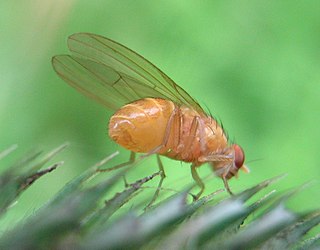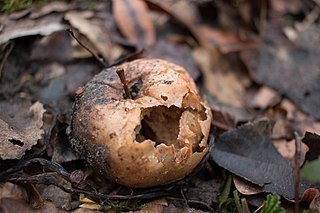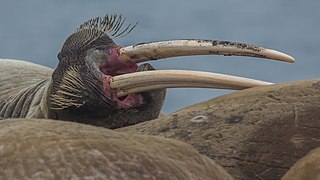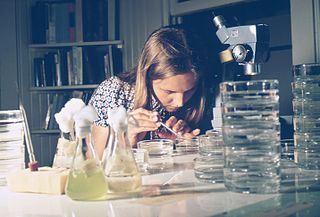
The Burgess Shale is a fossil-bearing deposit exposed in the Canadian Rockies of British Columbia, Canada. It is famous for the exceptional preservation of the soft parts of its fossils. At 508 million years old, it is one of the earliest fossil beds containing soft-part imprints.

Biology – The natural science that involves the study of life and living organisms, including their structure, function, growth, origin, evolution, distribution, and taxonomy.

Sedimentary rocks are types of rock that are formed by the accumulation or deposition of mineral or organic particles at the Earth's surface, followed by cementation. Sedimentation is the collective name for processes that cause these particles to settle in place. The particles that form a sedimentary rock are called sediment, and may be composed of geological detritus (minerals) or biological detritus. The geological detritus originated from weathering and erosion of existing rocks, or from the solidification of molten lava blobs erupted by volcanoes. The geological detritus is transported to the place of deposition by water, wind, ice or mass movement, which are called agents of denudation. Biological detritus was formed by bodies and parts of dead aquatic organisms, as well as their fecal mass, suspended in water and slowly piling up on the floor of water bodies. Sedimentation may also occur as dissolved minerals precipitate from water solution.

Environmental science is an interdisciplinary academic field that integrates physical, biological and information sciences to the study of the environment, and the solution of environmental problems. Environmental science emerged from the fields of natural history and medicine during the Enlightenment. Today it provides an integrated, quantitative, and interdisciplinary approach to the study of environmental systems.

Diagenesis is the process that describes physical and chemical changes in sediments first caused by water-rock interactions, microbial activity and compaction after their deposition. The increase of pressure and temperature only starts to play a role as sediments get buried much deeper in the Earth's crust. In the early stages, the transformation of poorly consolidated sediments into sedimentary rock (lithification) is simply accompanied by a reduction in porosity and water expulsion, while their main mineralogical assemblages remain unaltered. As the rock is carried deeper by further deposition above, its organic content is progressively transformed into kerogens and bitumens. The process of diagenesis excludes surface alteration (weathering) and deep metamorphism. There is no sharp boundary between diagenesis and metamorphism, but the latter occurs at higher temperatures and pressures. Hydrothermal solutions, meteoric groundwater, rock porosity, permeability, dissolution/precipitation reactions, and time are all influential factors.

Decomposition is the process by which dead organic substances are broken down into simpler organic or inorganic matter such as carbon dioxide, water, simple sugars and mineral salts. The process is a part of the nutrient cycle and is essential for recycling the finite matter that occupies physical space in the biosphere. Bodies of living organisms begin to decompose shortly after death. Animals, such as worms, also help decompose the organic materials. Organisms that do this are known as decomposers. Although no two organisms decompose in the same way, they all undergo the same sequential stages of decomposition. The science which studies decomposition is generally referred to as taphonomy from the Greek word taphos, meaning tomb. Decomposition can also be a gradual process for organisms that have extended periods of dormancy.

Taphonomy is the study of how organisms decay and become fossilized or preserved in the archaeological record. The term taphonomy was introduced to paleontology in 1940 by Soviet scientist Ivan Efremov to describe the study of the transition of remains, parts, or products of organisms from the biosphere to the lithosphere.

A Lagerstätte is a sedimentary deposit that exhibits extraordinary fossils with exceptional preservation—sometimes including preserved soft tissues. These formations may have resulted from carcass burial in an anoxic environment with minimal bacteria, thus delaying the decomposition of both gross and fine biological features until long after a durable impression was created in the surrounding matrix. Lagerstätten span geological time from the Neoproterozoic era to the present. Worldwide, some of the best examples of near-perfect fossilization are the Cambrian Maotianshan shales and Burgess Shale, the Devonian Hunsrück Slates and Gogo Formation, the Carboniferous Mazon Creek, the Jurassic Solnhofen limestone, the Cretaceous Santana, Yixian formations, the Eocene Green River Formation, and the Miocene Foulden Maar.

Paleoecology is the study of interactions between organisms and/or interactions between organisms and their environments across geologic timescales. As a discipline, paleoecology interacts with, depends on and informs a variety of fields including paleontology, ecology, climatology and biology.

A biogenic substance is a product made by or of life forms. While the term originally was specific to metabolite compounds that had toxic effects on other organisms, it has developed to encompass any constituents, secretions, and metabolites of plants or animals. In context of molecular biology, biogenic substances are referred to as biomolecules. They are generally isolated and measured through the use of chromatography and mass spectrometry techniques. Additionally, the transformation and exchange of biogenic substances can by modelled in the environment, particularly their transport in waterways.

Bioturbation is defined as the reworking of soils and sediments by animals or plants. These include burrowing, ingestion, and defecation of sediment grains. Bioturbating activities have a profound effect on the environment and are thought to be a primary driver of biodiversity. The formal study of bioturbation began in the 1800s by Charles Darwin experimenting in his garden. The disruption of aquatic sediments and terrestrial soils through bioturbating activities provides significant ecosystem services. These include the alteration of nutrients in aquatic sediment and overlying water, shelter to other species in the form of burrows in terrestrial and water ecosystems, and soil production on land.

A biologist is a professional who has specialized knowledge in the field of biology, understanding the underlying mechanisms that govern the functioning of biological systems within fields such as health, technology and the environment. Biologists involved in fundamental research attempt to explore and further explain the underlying mechanisms that govern the functioning of living matter. Biologists involved in applied research attempt to develop or improve more specific processes and understanding, in fields such as medicine and industry.
Derek Ernest Gilmor Briggs is an Irish palaeontologist and taphonomist based at Yale University. Briggs is one of three palaeontologists, along with Harry Blackmore Whittington and Simon Conway Morris, who were key in the reinterpretation of the fossils of the Burgess Shale. He is the Yale University G. Evelyn Hutchinson Professor of Geology and Geophysics, Curator of Invertebrate Paleontology at Yale's Peabody Museum of Natural History, and former Director of the Peabody Museum.
The following outline is provided as an overview of and topical guide to ecology:
The Burgess Shale of British Columbia is famous for its exceptional preservation of mid-Cambrian organisms. Around 40 other sites have been discovered of a similar age, with soft tissues preserved in a similar, though not identical, fashion. Additional sites with a similar form of preservation are known from the Ediacaran and Ordovician periods.
The preservational regime of Beecher's Trilobite Bed and other similar localities involves the replacement of soft tissues with pyrite, producing a three-dimensional fossil replicating the anatomy of the original organism. Only gross morphological information is preserved, although the fossils are compressed some relief is preserved.
A megabias, or a taphonomic megabias is a large scale pattern in the quality of the fossil record that affects paleobiologic analysis at provincial to global levels and at timescales usually exceeding ten million years. It can result from major shifts in intrinsic and extrinsic properties of organisms, including morphology and behaviour in relation to other organisms, or shifts in the global environment, which can cause secular or long-term cyclic changes in preservation.
The following outline is provided as an overview of and topical guide to natural science:
Most fossils represent mineralized material such as bone or shells. However, biopolymers such as chitin and collagen can sometimes leave fossils – most famously in Burgess Shale type preservation and palynomorphs. The preservation of soft tissue is not as rare as sometimes thought.

Egg taphonomy is the study of the decomposition and fossilization of eggs. The processes of egg taphonomy begin when the egg either hatches or dies. Eggshell fragments are robust and can often travel great distances before burial. More complete egg specimens gradually begin to fill with sediment, which hardens as minerals precipitate out of water percolating through pores or cracks in the shell. Throughout the fossilization process the calcium carbonate composing the eggshell generally remains unchanged, allowing scientists to study its original structure. However, egg fossils buried under sediments at great depth can be subjected to heat, pressure and chemical processes that can alter the structure of its shell through a process called diagenesis.











